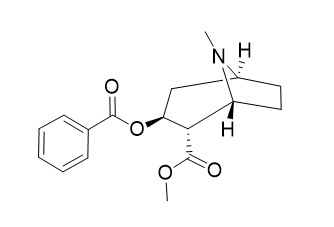Pseudococaine
Pseudococaine produces high-voltage slow waves (HVSWs) in the EEG associated with behavioral depression, it is more potent than cocaine in producing convulsions in the same monkeys.
Inquire / Order:
manager@chemfaces.com
Technical Inquiries:
service@chemfaces.com
Tel:
+86-27-84237783
Fax:
+86-27-84254680
Address:
1 Building, No. 83, CheCheng Rd., Wuhan Economic and Technological Development Zone, Wuhan, Hubei 430056, PRC
Providing storage is as stated on the product vial and the vial is kept tightly sealed, the product can be stored for up to
24 months(2-8C).
Wherever possible, you should prepare and use solutions on the same day. However, if you need to make up stock solutions in advance, we recommend that you store the solution as aliquots in tightly sealed vials at -20C. Generally, these will be useable for up to two weeks. Before use, and prior to opening the vial we recommend that you allow your product to equilibrate to room temperature for at least 1 hour.
Need more advice on solubility, usage and handling? Please email to: service@chemfaces.com
The packaging of the product may have turned upside down during transportation, resulting in the natural compounds adhering to the neck or cap of the vial. take the vial out of its packaging and gently shake to let the compounds fall to the bottom of the vial. for liquid products, centrifuge at 200-500 RPM to gather the liquid at the bottom of the vial. try to avoid loss or contamination during handling.
Front Chem.2022, 10:1048467.
Pest Manag Sci.2019, 75(9):2530-2541
Molecules.2019, 24(16):E2985
Korean J Dent Mater2020, 47(2):63-70.
Neurochem Int.2023, 167:105537.
Plant Cell Tiss Org2020, 1-16
Food Sci Biotechnol.2024, 34(3):611-620.
Molecules.2019, 24(4):E744
BioRxiv-The Preprint server for biology2023, 586957.
J Nat Prod.2018, 81(4):966-975
Related and Featured Products
Brain Res Bull. 1978 Jul-Aug;3(4):341-7.
Cocaine and pseudococaine: comparative effects on electrical after-discharge in the limbic system of cats.[Pubmed:
318203 ]
METHODS AND RESULTS:
The effects of cocaine and its dextroisomer Pseudococaine on electrical after-discharge (AD) evoked by electrical stimulation of the hippocampus or amygdala were studied in cats with electrodes implanted in the brain. Intravenous injection of cocaine (2.0 to 4.0 mg/kg doses) produced a suppressive effect on the AD while producing low-voltage fast waves (LVFWs) in the electrical activities of the brain (EEG) associated with behavioral excitation. In contrast, Pseudococaine at the same dose as cocaine failed to show a significant suppressive effect on the AD except at high doses (5.0 mg/kg). Pseudococaine produced high-voltage slow waves (HVSWs) in the EEG associated with behavioral depression. A linear dose-response relationship was observed for the suppressive effect of cocaine on the AD.
CONCLUSIONS:
The results suggested that the limbic system may be involved as a primary site of action of cocaine in the central nervous system (CNS).
Brain Res Bull. 1977 Nov-Dec;2(6):417-24.
Comparison of the convulsant effects of cocaine and pseudococaine in the rhesus monkey.[Pubmed:
414826]
METHODS AND RESULTS:
The convulsant effects of cocaine and its C2-epimer, Pseudococaine on EEG, respiration, heart rate and behavior were studied in the rhesus monkeys with electrodes implanted in the brain. Intravenous injections of cocaine (3.0 to 8.0 mg/kg) and Pseudococaine (3.0 to 7.0 mg/kg) in the animals produced a similar pattern of clonic convulsions accompanied by marked increases in the heart and respiratory rates with mydriasis and excessive salivation. However, both isomers showed different effects on the EEG and animal's behavior following convulsions; e.g., the cocaine-induced convulsions were followed by low-voltage fast waves in the EEGs associated with behavioral hyperexcitation, while Pseudococaine-induced convulsions were followed by high-voltage slow waves associated with behavioral depression and drowsiness with intermittent sleep.
CONCLUSIONS:
Pseudococaine was more potent than cocaine in producing convulsions in the same monkeys. The durations of convulsions produced by these drugs were dose-dependent.
Psychopharmacology (Berl). 1978 Apr 14;57(1):13-20.
Comparative effects of cocaine and pseudococaine on EEG activities, cardiorespiratory functions, and self-administration behavior in the rhesus monkey.[Pubmed:
96463]
The effects of cocaine and Pseudococaine on the EEGs, heart and respiratory rates, and self-administration behavior were studied in rhesus monkeys.
METHODS AND RESULTS:
An intravenous injection of cocaine (2.5 and 4.0 mg/kg) in the monkey produced low-voltage fast waves (LVFWs) in the EEGs and behavioral hyperexcitation accompanied by marked increases in the heart and respiratory rates with mydriasis and excessive salivation. In contrast, Pseudococaine produced high-voltage slow waves (HVSWs) in the EEGs and behavioral depression accompanied by the same symptoms of the autonomic functions as those produced by cocaine. Both isomers were self-administered by the monkeys. During cocaine self-administration sessions, the animals showed hyperexcitation in their overall behavior, while with Pseudococaine they showed almost normal behavioral responses.
CONCLUSIONS:
These results suggest that cocaine produced excitatory effects and Pseudococaine inhibitory effects on the EEGs and behavior. Both isomers stimulate the heart and respiratory rates, and were self-administered by the monkeys.
Org Lett. 2012 Aug 17;14(16):4278-81.
Asymmetric synthesis of the tropane alkaloid (+)-pseudococaine via ring-closing iodoamination.[Pubmed:
22866940]
METHODS AND RESULTS:
Ring-closing iodoamination of tert-butyl 2-hydroxy-7-[N-methyl-N-(α-methyl-p-methoxybenzyl)amino]cyclohept-3-ene-1-carboxylates proceeds with concomitant loss of the N-α-methyl-p-methoxybenzyl group to give the corresponding 8-azabicyclo[3.2.1]octane scaffolds in >99:1 dr. Subsequent elaboration of one of these templates provided access to (+)-Pseudococaine hydrochloride, in seven steps and 31% overall yield from commercially available starting materials.
J Forensic Sci. 1994 Nov;39(6):1537-43.
Detection and determination of pseudococaine in coca leaves and illicit cocaine samples.[Pubmed:
7815033]
METHODS AND RESULTS:
Methodology is presented for the isolation, identification and determination of Pseudococaine in coca leaves and illicit cocaine. Coca leaves, crude cocaine base (coca paste), refined cocaine base and refined cocaine hydrochloride, all derived from the same geographic location in Bolivia, were examined. Pseudococaine and other coca alkaloids were isolated from leaf samples using toluene extraction followed by acid/Celite trap and ion-pair column chromatography, and from crude and refined cocaine samples by acid/Celite column ion-pairing chromatography.
CONCLUSIONS:
Mass spectral analysis of coca leaf isolates confirmed the presence of Pseudococaine. Pseudococaine was quantified by capillary gas chromatography with flame ionization detection at levels of 0.0001-0.035% (relative to cocaine) in refined illicit cocaine and coca leaves.



